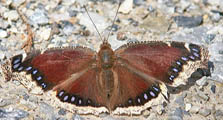Native Plants
Search for native plants by scientific name, common name or family. If you are not sure what you are looking for, try the Combination Search or our Recommended Species lists.
Rosa nutkana
Rosa nutkana C. Presl
Nootka Rose
Rosaceae (Rose Family)
Synonym(s):
USDA Symbol: ronu
USDA Native Status: L48 (N), AK (N), CAN (N)
Nootka rose is a 2-10 ft., sometimes taller, prickly to nearly unarmed, wild rose with extraordinarily large, solitary (sometimes 2-3 in a cluster), pink flowers at branch ends. The flowers, which can be up to 3 1/2 in. across, are followed by big, purplish, pear-shaped hips. The light-green leaves are pinnately compound. A thorny shrub with pale pink flowers, the largest (often only) thorns in pairs near leaf stalks.
The hips, or fruit, of any wild roses may be eaten and are often used to make jams and jellies. Sweetbrier (R. eglanteria), the "Eglantine" of Shakespeare and Chaucer, has many down-curved prickles on the stem, and minute glands on the leaves and sepals, giving a pleasant rose aroma. Introduced in North America, it is fairly common west of the Cascade Mountains and the Sierra Nevada.
Plant Characteristics
Duration: PerennialHabit: Shrub
Leaf Retention: Deciduous
Fruit Type: Achene
Size Notes: Up to about 12 feet tall, often shorter.
Leaf: Dark green.
Fruit: Purple to red hip (mature floral tube) surrounding achenes.
Bloom Information
Bloom Color: Red , PinkBloom Time: Apr , May , Jun , Jul , Aug
Distribution
USA: AK , CA , CO , ID , MT , NV , OR , UT , WA , WYCanada: BC
Native Distribution: AK, s. to n. CA & in the Rockies s. to CO & UT
Native Habitat: Dryish to moist, wooded to open sites
Growing Conditions
Water Use: HighLight Requirement: Sun , Part Shade , Shade
Soil Moisture: Dry , Moist
CaCO3 Tolerance: Low
Soil Description: Moist to drier soils.
Conditions Comments: In areas where both R. nutkana and R. woodsii occur, R. nutkana is typically at higher elevations. It is susceptible to fungal problems.
Benefit
Use Wildlife: BeesWarning: Plant has thorns or prickles.
Conspicuous Flowers: yes
Fragrant Flowers: yes
Fragrant Foliage: yes
Attracts: Butterflies
Larval Host: Mourning cloak and grey hairstreak butterflies
Value to Beneficial Insects
Special Value to Native BeesSpecial Value to Bumble Bees
Provides Nesting Materials/Structure for Native Bees
This information was provided by the Pollinator Program at The Xerces Society for Invertebrate Conservation.
Butterflies and Moths of North America (BAMONA)
|
Mourning Cloak (Nymphalis antiopa)  Larval Host |
Propagation
Description: Seeds removed from dried hips germinate slowly; outside stratification over a winter helps. Small offsets from the parent root transplant well.Seed Collection: Hips can be collected as soon as they are ripe. Achenes can then be extracted by macerating the hips in water and recovering the seeds by flotation.
Commercially Avail: yes
Find Seed or Plants
Find seed sources for this species at the Native Seed Network.
National Wetland Indicator Status
| Region: | AGCP | AK | AW | CB | EMP | GP | HI | MW | NCNE | WMVE |
| Status: | FACU | FACU | FACU | FAC |
From the National Organizations Directory
According to the species list provided by Affiliate Organizations, this plant is on display at the following locations:Native Seed Network - Corvallis, OR
Bibliography
Bibref 1186 - Field Guide to Moths of Eastern North America (2005) Covell, C.V., Jr.Bibref 1185 - Field Guide to Western Butterflies (Peterson Field Guides) (1999) Opler, P.A. and A.B. Wright
Search More Titles in Bibliography
Web Reference
Webref 30 - Calflora (2018) CalfloraWebref 38 - Flora of North America (2019) Missouri Botanical Garden, St. Louis, MO & Harvard University Herbaria, Cambridge, MA.
Webref 23 - Southwest Environmental Information Network (2009) SEINet - Arizona Chapter
Additional resources
USDA: Find Rosa nutkana in USDA PlantsFNA: Find Rosa nutkana in the Flora of North America (if available)
Google: Search Google for Rosa nutkana
Metadata
Record Modified: 2022-10-20Research By: TWC Staff